Human Factors & M&A: A Literature Review on Performance Impacts
VerifiedAdded on 2023/06/10
|32
|14145
|412
Literature Review
AI Summary
This literature review investigates the impact of human factors on the performance of mergers and acquisitions (M&As), drawing from papers published in leading management journals since 1990. The review identifies three main categories of human impact: individual-related, organizational-related, and managerial-related factors. Individual factors include psychological effects on employees, such as stress and anxiety, and turnover, particularly among top management. Organizational factors focus on cultural differences between merging companies and the capacity to transfer resources. Managerial factors involve the actions and decisions made by managers during the acquisition process, including integration policies and the degree of autonomy granted to the acquired firm. The review highlights that while research in this area is extensive, many studies examine influential factors in isolation without directly linking them to post-acquisition outcomes, emphasizing the need for a more integrated approach to understanding human impacts on M&A success. Desklib provides access to this and other solved assignments for students.
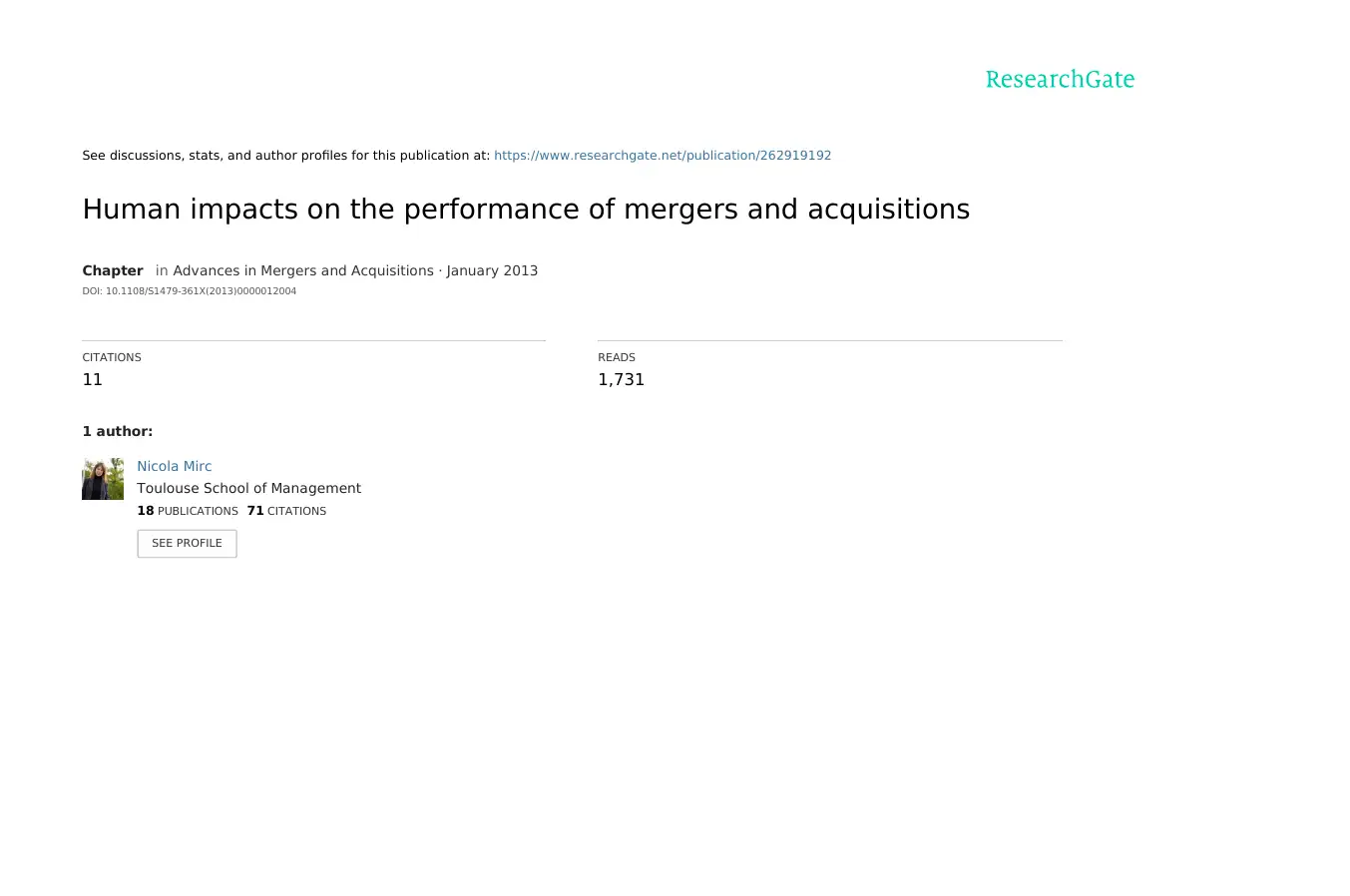
See discussions, stats, and author profiles for this publication at: https://www.researchgate.net/publication/262919192
Human impacts on the performance of mergers and acquisitions
Chapter in Advances in Mergers and Acquisitions · January 2013
DOI: 10.1108/S1479-361X(2013)0000012004
CITATIONS
11
READS
1,731
1 author:
Nicola Mirc
Toulouse School of Management
18 PUBLICATIONS 71 CITATIONS
SEE PROFILE
Human impacts on the performance of mergers and acquisitions
Chapter in Advances in Mergers and Acquisitions · January 2013
DOI: 10.1108/S1479-361X(2013)0000012004
CITATIONS
11
READS
1,731
1 author:
Nicola Mirc
Toulouse School of Management
18 PUBLICATIONS 71 CITATIONS
SEE PROFILE
Paraphrase This Document
Need a fresh take? Get an instant paraphrase of this document with our AI Paraphraser
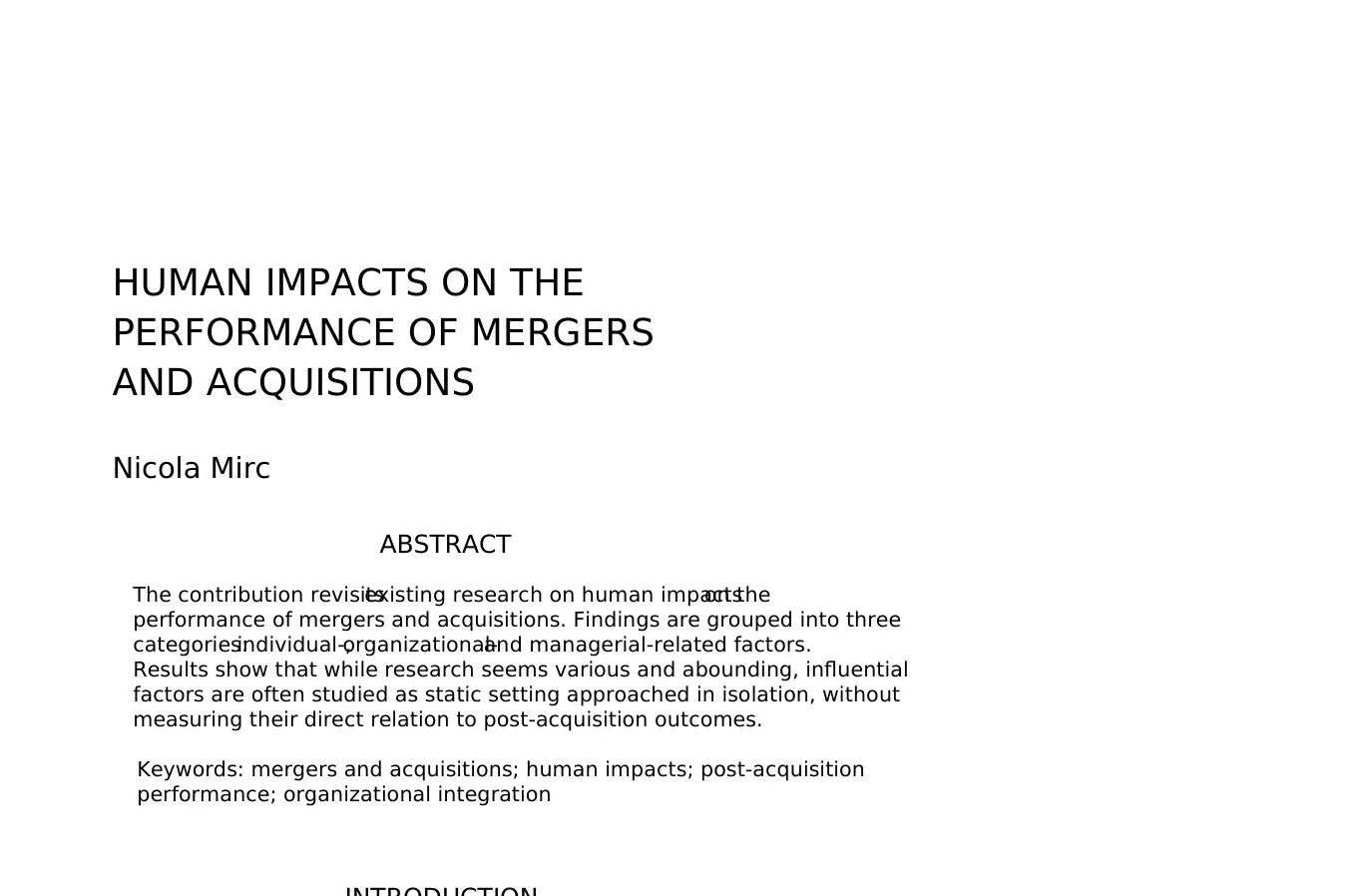
HUMAN IMPACTS ON THE
PERFORMANCE OF MERGERS
AND ACQUISITIONS
Nicola Mirc
ABSTRACT
The contribution revisitsexisting research on human impactson the
performance of mergers and acquisitions. Findings are grouped into three
categories:individual-,organizational-and managerial-related factors.
Results show that while research seems various and abounding, influential
factors are often studied as static setting approached in isolation, without
measuring their direct relation to post-acquisition outcomes.
Keywords: mergers and acquisitions; human impacts; post-acquisition
performance; organizational integration
PERFORMANCE OF MERGERS
AND ACQUISITIONS
Nicola Mirc
ABSTRACT
The contribution revisitsexisting research on human impactson the
performance of mergers and acquisitions. Findings are grouped into three
categories:individual-,organizational-and managerial-related factors.
Results show that while research seems various and abounding, influential
factors are often studied as static setting approached in isolation, without
measuring their direct relation to post-acquisition outcomes.
Keywords: mergers and acquisitions; human impacts; post-acquisition
performance; organizational integration
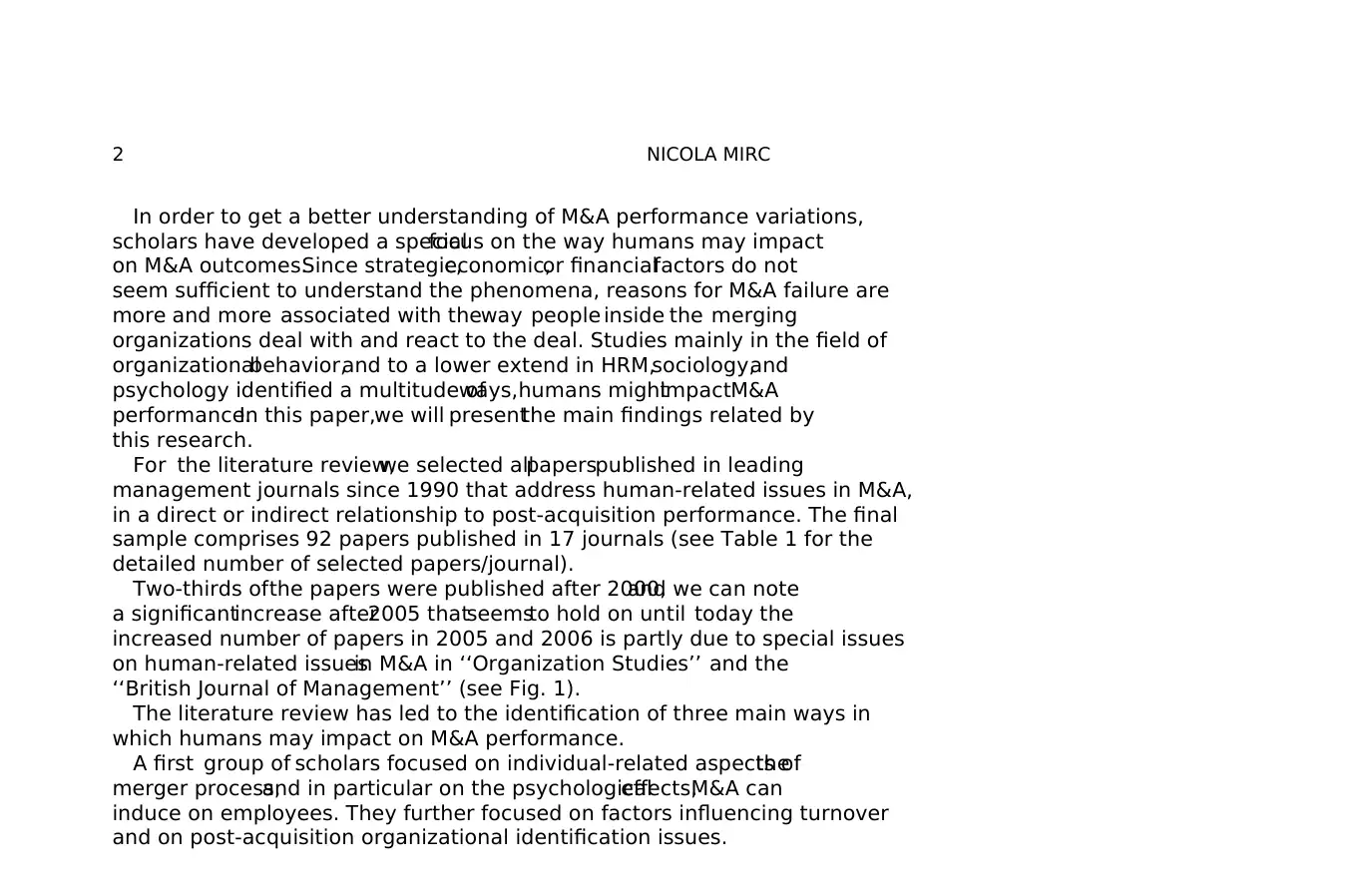
In order to get a better understanding of M&A performance variations,
scholars have developed a specialfocus on the way humans may impact
on M&A outcomes.Since strategic,economic,or financialfactors do not
seem sufficient to understand the phenomena, reasons for M&A failure are
more and more associated with theway people inside the merging
organizations deal with and react to the deal. Studies mainly in the field of
organizationalbehavior,and to a lower extend in HRM,sociology,and
psychology identified a multitude ofways,humans mightimpactM&A
performance.In this paper,we will presentthe main findings related by
this research.
For the literature review,we selected allpaperspublished in leading
management journals since 1990 that address human-related issues in M&A,
in a direct or indirect relationship to post-acquisition performance. The final
sample comprises 92 papers published in 17 journals (see Table 1 for the
detailed number of selected papers/journal).
Two-thirds ofthe papers were published after 2000,and we can note
a significantincrease after2005 thatseemsto hold on until today the
increased number of papers in 2005 and 2006 is partly due to special issues
on human-related issuesin M&A in ‘‘Organization Studies’’ and the
‘‘British Journal of Management’’ (see Fig. 1).
The literature review has led to the identification of three main ways in
which humans may impact on M&A performance.
A first group of scholars focused on individual-related aspects ofthe
merger process,and in particular on the psychologicaleffects,M&A can
induce on employees. They further focused on factors influencing turnover
and on post-acquisition organizational identification issues.
NICOLA MIRC2
scholars have developed a specialfocus on the way humans may impact
on M&A outcomes.Since strategic,economic,or financialfactors do not
seem sufficient to understand the phenomena, reasons for M&A failure are
more and more associated with theway people inside the merging
organizations deal with and react to the deal. Studies mainly in the field of
organizationalbehavior,and to a lower extend in HRM,sociology,and
psychology identified a multitude ofways,humans mightimpactM&A
performance.In this paper,we will presentthe main findings related by
this research.
For the literature review,we selected allpaperspublished in leading
management journals since 1990 that address human-related issues in M&A,
in a direct or indirect relationship to post-acquisition performance. The final
sample comprises 92 papers published in 17 journals (see Table 1 for the
detailed number of selected papers/journal).
Two-thirds ofthe papers were published after 2000,and we can note
a significantincrease after2005 thatseemsto hold on until today the
increased number of papers in 2005 and 2006 is partly due to special issues
on human-related issuesin M&A in ‘‘Organization Studies’’ and the
‘‘British Journal of Management’’ (see Fig. 1).
The literature review has led to the identification of three main ways in
which humans may impact on M&A performance.
A first group of scholars focused on individual-related aspects ofthe
merger process,and in particular on the psychologicaleffects,M&A can
induce on employees. They further focused on factors influencing turnover
and on post-acquisition organizational identification issues.
NICOLA MIRC2
⊘ This is a preview!⊘
Do you want full access?
Subscribe today to unlock all pages.

Trusted by 1+ million students worldwide
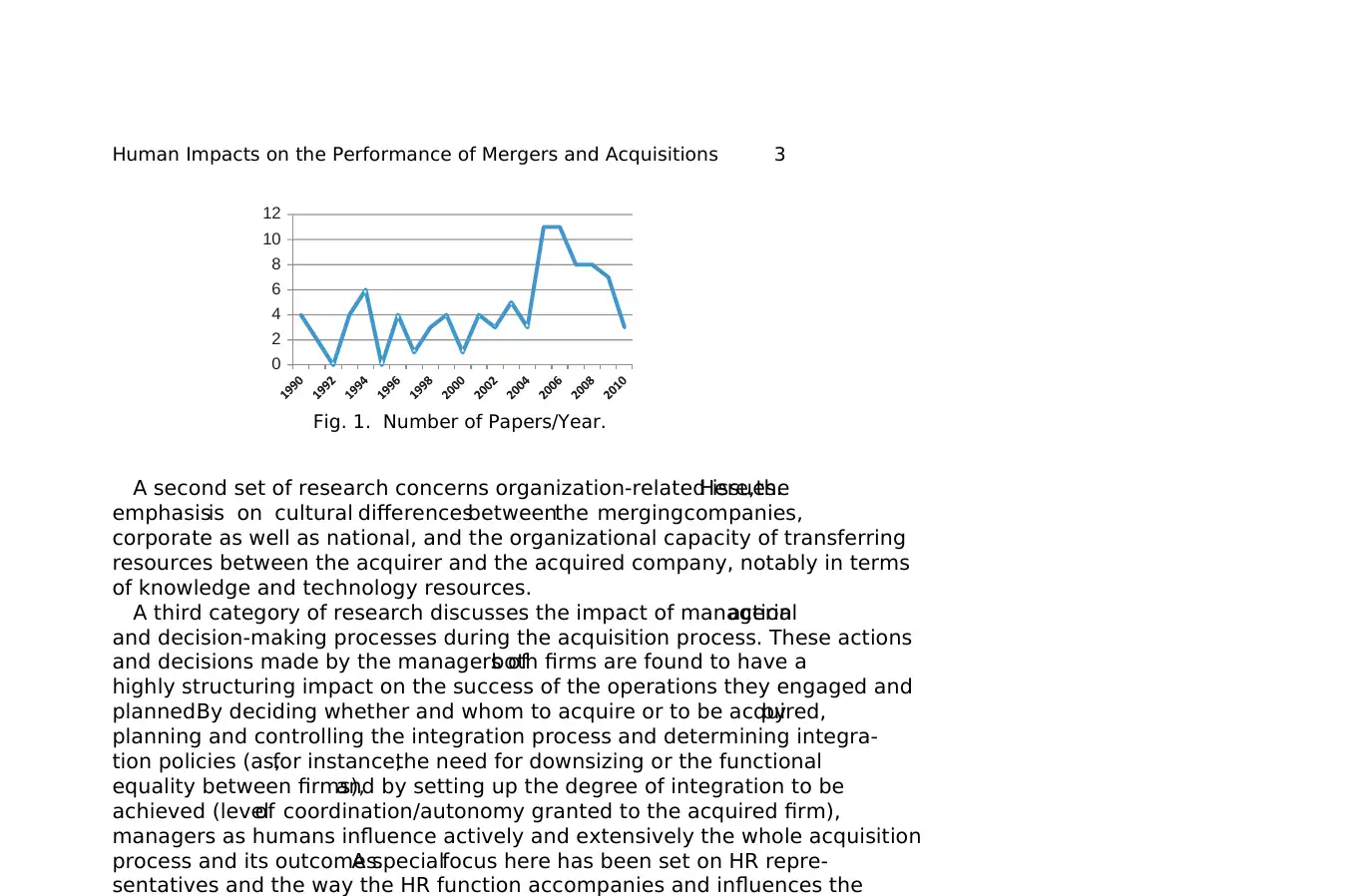
A second set of research concerns organization-related issues.Here,the
emphasisis on cultural differencesbetweenthe mergingcompanies,
corporate as well as national, and the organizational capacity of transferring
resources between the acquirer and the acquired company, notably in terms
of knowledge and technology resources.
A third category of research discusses the impact of managerialaction
and decision-making processes during the acquisition process. These actions
and decisions made by the managers ofboth firms are found to have a
highly structuring impact on the success of the operations they engaged and
planned.By deciding whether and whom to acquire or to be acquired,by
planning and controlling the integration process and determining integra-
tion policies (as,for instance,the need for downsizing or the functional
equality between firms),and by setting up the degree of integration to be
achieved (levelof coordination/autonomy granted to the acquired firm),
managers as humans influence actively and extensively the whole acquisition
process and its outcomes.A specialfocus here has been set on HR repre-
sentatives and the way the HR function accompanies and influences the
0
2
4
6
8
10
12
Fig. 1. Number of Papers/Year.
Human Impacts on the Performance of Mergers and Acquisitions 3
emphasisis on cultural differencesbetweenthe mergingcompanies,
corporate as well as national, and the organizational capacity of transferring
resources between the acquirer and the acquired company, notably in terms
of knowledge and technology resources.
A third category of research discusses the impact of managerialaction
and decision-making processes during the acquisition process. These actions
and decisions made by the managers ofboth firms are found to have a
highly structuring impact on the success of the operations they engaged and
planned.By deciding whether and whom to acquire or to be acquired,by
planning and controlling the integration process and determining integra-
tion policies (as,for instance,the need for downsizing or the functional
equality between firms),and by setting up the degree of integration to be
achieved (levelof coordination/autonomy granted to the acquired firm),
managers as humans influence actively and extensively the whole acquisition
process and its outcomes.A specialfocus here has been set on HR repre-
sentatives and the way the HR function accompanies and influences the
0
2
4
6
8
10
12
Fig. 1. Number of Papers/Year.
Human Impacts on the Performance of Mergers and Acquisitions 3
Paraphrase This Document
Need a fresh take? Get an instant paraphrase of this document with our AI Paraphraser
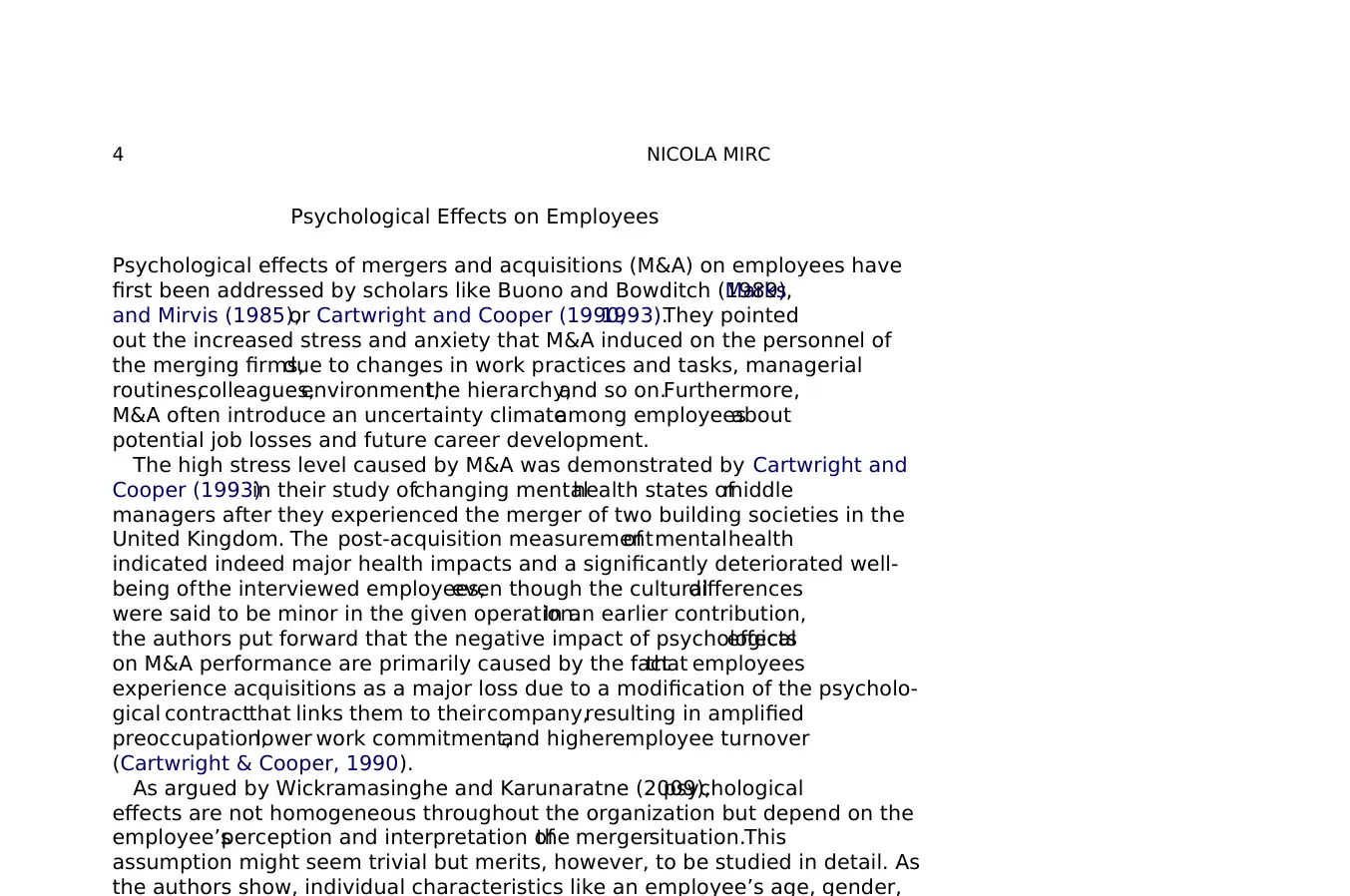
Psychological Effects on Employees
Psychological effects of mergers and acquisitions (M&A) on employees have
first been addressed by scholars like Buono and Bowditch (1989),Marks
and Mirvis (1985),or Cartwright and Cooper (1990,1993).They pointed
out the increased stress and anxiety that M&A induced on the personnel of
the merging firms,due to changes in work practices and tasks, managerial
routines,colleagues,environment,the hierarchy,and so on.Furthermore,
M&A often introduce an uncertainty climateamong employeesabout
potential job losses and future career development.
The high stress level caused by M&A was demonstrated by Cartwright and
Cooper (1993)in their study ofchanging mentalhealth states ofmiddle
managers after they experienced the merger of two building societies in the
United Kingdom. The post-acquisition measurementof mentalhealth
indicated indeed major health impacts and a significantly deteriorated well-
being ofthe interviewed employees,even though the culturaldifferences
were said to be minor in the given operation.In an earlier contribution,
the authors put forward that the negative impact of psychologicaleffects
on M&A performance are primarily caused by the factthat employees
experience acquisitions as a major loss due to a modification of the psycholo-
gical contractthat links them to theircompany,resulting in amplified
preoccupation,lower work commitment,and higheremployee turnover
(Cartwright & Cooper, 1990).
As argued by Wickramasinghe and Karunaratne (2009),psychological
effects are not homogeneous throughout the organization but depend on the
employee’sperception and interpretation ofthe mergersituation.This
assumption might seem trivial but merits, however, to be studied in detail. As
the authors show, individual characteristics like an employee’s age, gender,
NICOLA MIRC4
Psychological effects of mergers and acquisitions (M&A) on employees have
first been addressed by scholars like Buono and Bowditch (1989),Marks
and Mirvis (1985),or Cartwright and Cooper (1990,1993).They pointed
out the increased stress and anxiety that M&A induced on the personnel of
the merging firms,due to changes in work practices and tasks, managerial
routines,colleagues,environment,the hierarchy,and so on.Furthermore,
M&A often introduce an uncertainty climateamong employeesabout
potential job losses and future career development.
The high stress level caused by M&A was demonstrated by Cartwright and
Cooper (1993)in their study ofchanging mentalhealth states ofmiddle
managers after they experienced the merger of two building societies in the
United Kingdom. The post-acquisition measurementof mentalhealth
indicated indeed major health impacts and a significantly deteriorated well-
being ofthe interviewed employees,even though the culturaldifferences
were said to be minor in the given operation.In an earlier contribution,
the authors put forward that the negative impact of psychologicaleffects
on M&A performance are primarily caused by the factthat employees
experience acquisitions as a major loss due to a modification of the psycholo-
gical contractthat links them to theircompany,resulting in amplified
preoccupation,lower work commitment,and higheremployee turnover
(Cartwright & Cooper, 1990).
As argued by Wickramasinghe and Karunaratne (2009),psychological
effects are not homogeneous throughout the organization but depend on the
employee’sperception and interpretation ofthe mergersituation.This
assumption might seem trivial but merits, however, to be studied in detail. As
the authors show, individual characteristics like an employee’s age, gender,
NICOLA MIRC4
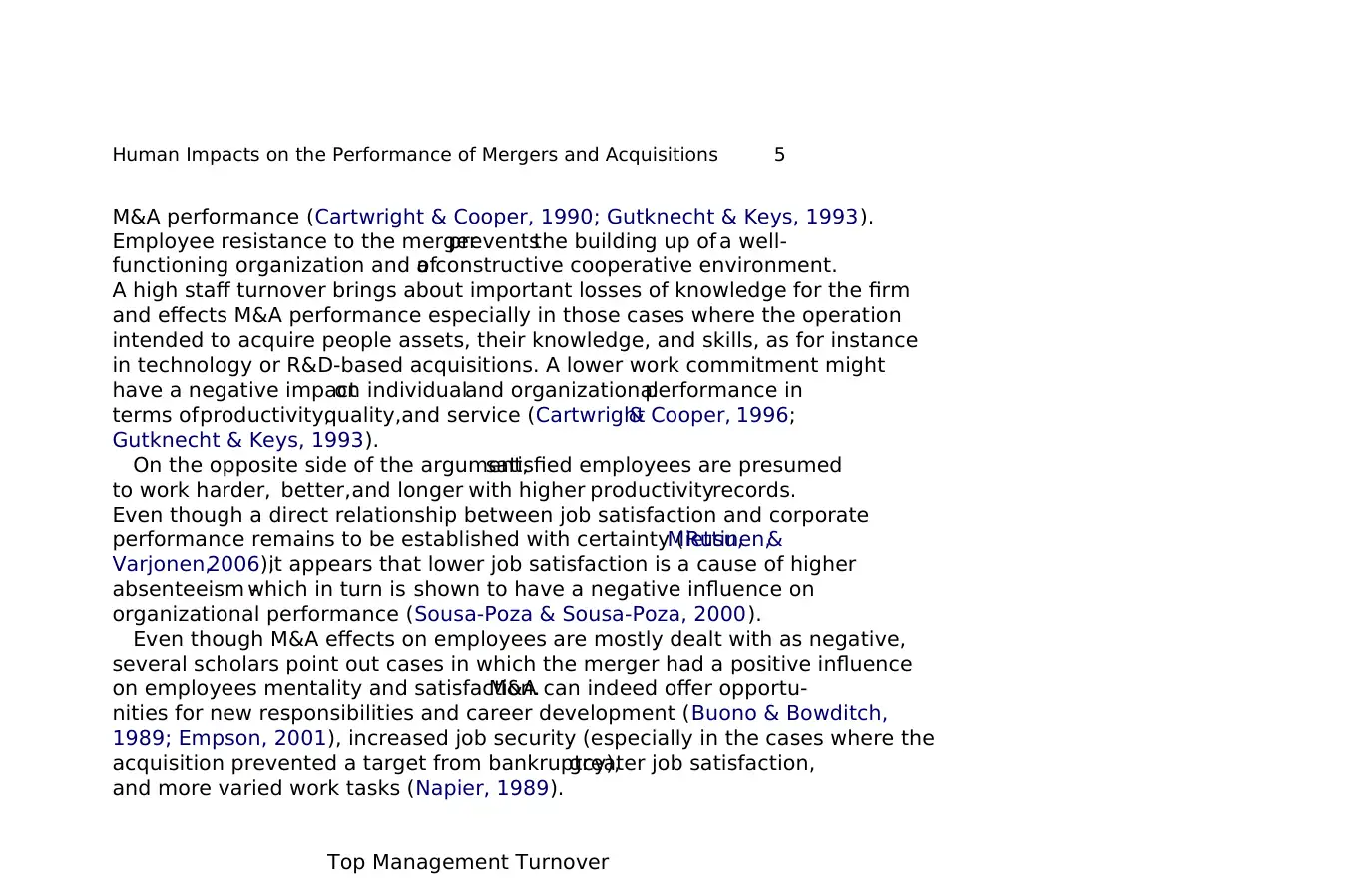
M&A performance (Cartwright & Cooper, 1990; Gutknecht & Keys, 1993).
Employee resistance to the mergerpreventsthe building up of a well-
functioning organization and ofa constructive cooperative environment.
A high staff turnover brings about important losses of knowledge for the firm
and effects M&A performance especially in those cases where the operation
intended to acquire people assets, their knowledge, and skills, as for instance
in technology or R&D-based acquisitions. A lower work commitment might
have a negative impacton individualand organizationalperformance in
terms ofproductivity,quality,and service (Cartwright& Cooper, 1996;
Gutknecht & Keys, 1993).
On the opposite side of the argument,satisfied employees are presumed
to work harder, better,and longer with higher productivityrecords.
Even though a direct relationship between job satisfaction and corporate
performance remains to be established with certainty (Rusu,Miettinen,&
Varjonen,2006),it appears that lower job satisfaction is a cause of higher
absenteeism -which in turn is shown to have a negative influence on
organizational performance (Sousa-Poza & Sousa-Poza, 2000).
Even though M&A effects on employees are mostly dealt with as negative,
several scholars point out cases in which the merger had a positive influence
on employees mentality and satisfaction.M&A can indeed offer opportu-
nities for new responsibilities and career development (Buono & Bowditch,
1989; Empson, 2001), increased job security (especially in the cases where the
acquisition prevented a target from bankruptcy),greater job satisfaction,
and more varied work tasks (Napier, 1989).
Top Management Turnover
Human Impacts on the Performance of Mergers and Acquisitions 5
Employee resistance to the mergerpreventsthe building up of a well-
functioning organization and ofa constructive cooperative environment.
A high staff turnover brings about important losses of knowledge for the firm
and effects M&A performance especially in those cases where the operation
intended to acquire people assets, their knowledge, and skills, as for instance
in technology or R&D-based acquisitions. A lower work commitment might
have a negative impacton individualand organizationalperformance in
terms ofproductivity,quality,and service (Cartwright& Cooper, 1996;
Gutknecht & Keys, 1993).
On the opposite side of the argument,satisfied employees are presumed
to work harder, better,and longer with higher productivityrecords.
Even though a direct relationship between job satisfaction and corporate
performance remains to be established with certainty (Rusu,Miettinen,&
Varjonen,2006),it appears that lower job satisfaction is a cause of higher
absenteeism -which in turn is shown to have a negative influence on
organizational performance (Sousa-Poza & Sousa-Poza, 2000).
Even though M&A effects on employees are mostly dealt with as negative,
several scholars point out cases in which the merger had a positive influence
on employees mentality and satisfaction.M&A can indeed offer opportu-
nities for new responsibilities and career development (Buono & Bowditch,
1989; Empson, 2001), increased job security (especially in the cases where the
acquisition prevented a target from bankruptcy),greater job satisfaction,
and more varied work tasks (Napier, 1989).
Top Management Turnover
Human Impacts on the Performance of Mergers and Acquisitions 5
⊘ This is a preview!⊘
Do you want full access?
Subscribe today to unlock all pages.

Trusted by 1+ million students worldwide
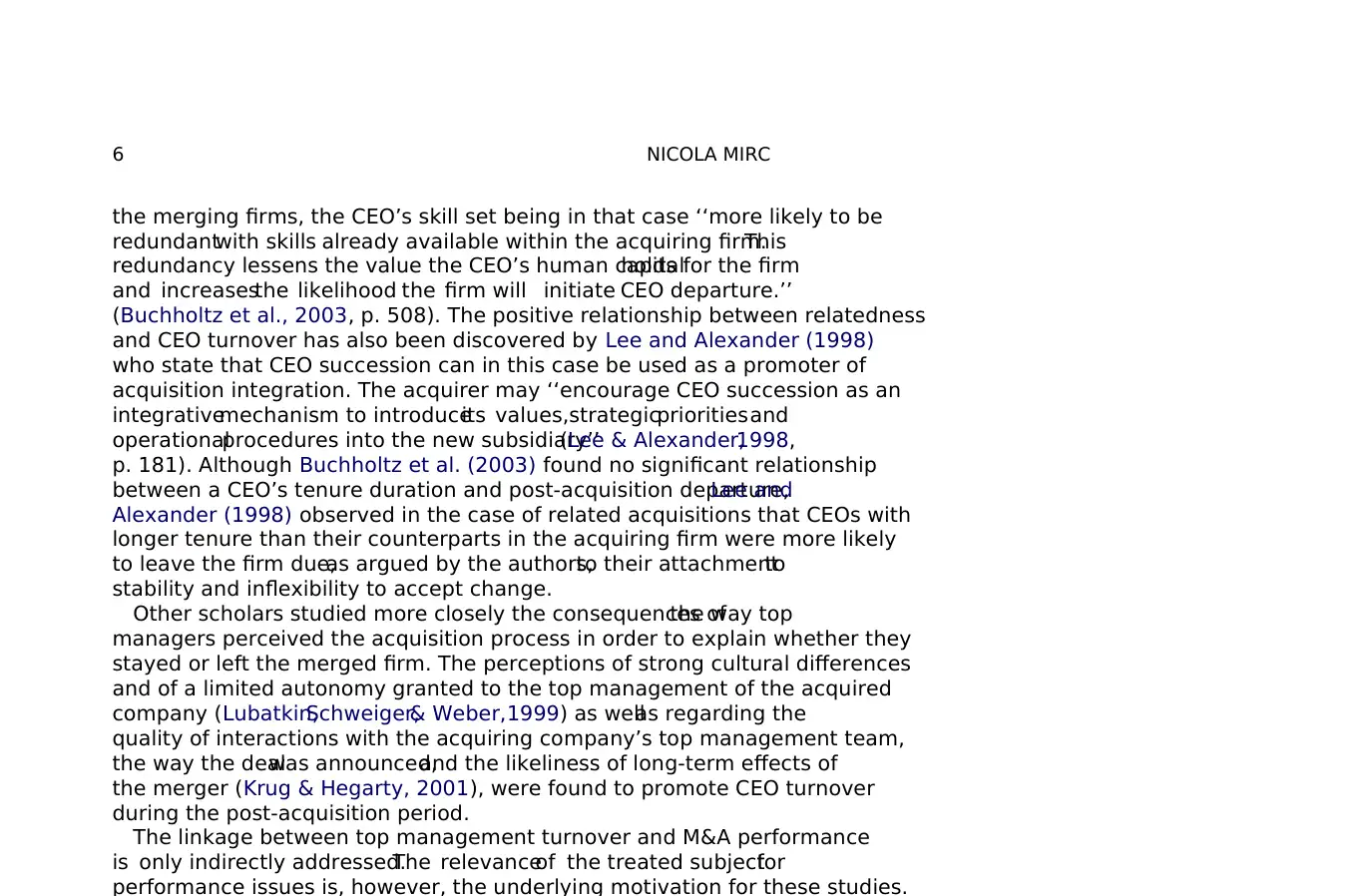
the merging firms, the CEO’s skill set being in that case ‘‘more likely to be
redundantwith skills already available within the acquiring firm.This
redundancy lessens the value the CEO’s human capitalholds for the firm
and increasesthe likelihood the firm will initiate CEO departure.’’
(Buchholtz et al., 2003, p. 508). The positive relationship between relatedness
and CEO turnover has also been discovered by Lee and Alexander (1998)
who state that CEO succession can in this case be used as a promoter of
acquisition integration. The acquirer may ‘‘encourage CEO succession as an
integrativemechanism to introduceits values,strategicprioritiesand
operationalprocedures into the new subsidiary’’(Lee & Alexander,1998,
p. 181). Although Buchholtz et al. (2003) found no significant relationship
between a CEO’s tenure duration and post-acquisition departure,Lee and
Alexander (1998) observed in the case of related acquisitions that CEOs with
longer tenure than their counterparts in the acquiring firm were more likely
to leave the firm due,as argued by the authors,to their attachmentto
stability and inflexibility to accept change.
Other scholars studied more closely the consequences ofthe way top
managers perceived the acquisition process in order to explain whether they
stayed or left the merged firm. The perceptions of strong cultural differences
and of a limited autonomy granted to the top management of the acquired
company (Lubatkin,Schweiger,& Weber,1999) as wellas regarding the
quality of interactions with the acquiring company’s top management team,
the way the dealwas announced,and the likeliness of long-term effects of
the merger (Krug & Hegarty, 2001), were found to promote CEO turnover
during the post-acquisition period.
The linkage between top management turnover and M&A performance
is only indirectly addressed.The relevanceof the treated subjectfor
performance issues is, however, the underlying motivation for these studies.
NICOLA MIRC6
redundantwith skills already available within the acquiring firm.This
redundancy lessens the value the CEO’s human capitalholds for the firm
and increasesthe likelihood the firm will initiate CEO departure.’’
(Buchholtz et al., 2003, p. 508). The positive relationship between relatedness
and CEO turnover has also been discovered by Lee and Alexander (1998)
who state that CEO succession can in this case be used as a promoter of
acquisition integration. The acquirer may ‘‘encourage CEO succession as an
integrativemechanism to introduceits values,strategicprioritiesand
operationalprocedures into the new subsidiary’’(Lee & Alexander,1998,
p. 181). Although Buchholtz et al. (2003) found no significant relationship
between a CEO’s tenure duration and post-acquisition departure,Lee and
Alexander (1998) observed in the case of related acquisitions that CEOs with
longer tenure than their counterparts in the acquiring firm were more likely
to leave the firm due,as argued by the authors,to their attachmentto
stability and inflexibility to accept change.
Other scholars studied more closely the consequences ofthe way top
managers perceived the acquisition process in order to explain whether they
stayed or left the merged firm. The perceptions of strong cultural differences
and of a limited autonomy granted to the top management of the acquired
company (Lubatkin,Schweiger,& Weber,1999) as wellas regarding the
quality of interactions with the acquiring company’s top management team,
the way the dealwas announced,and the likeliness of long-term effects of
the merger (Krug & Hegarty, 2001), were found to promote CEO turnover
during the post-acquisition period.
The linkage between top management turnover and M&A performance
is only indirectly addressed.The relevanceof the treated subjectfor
performance issues is, however, the underlying motivation for these studies.
NICOLA MIRC6
Paraphrase This Document
Need a fresh take? Get an instant paraphrase of this document with our AI Paraphraser
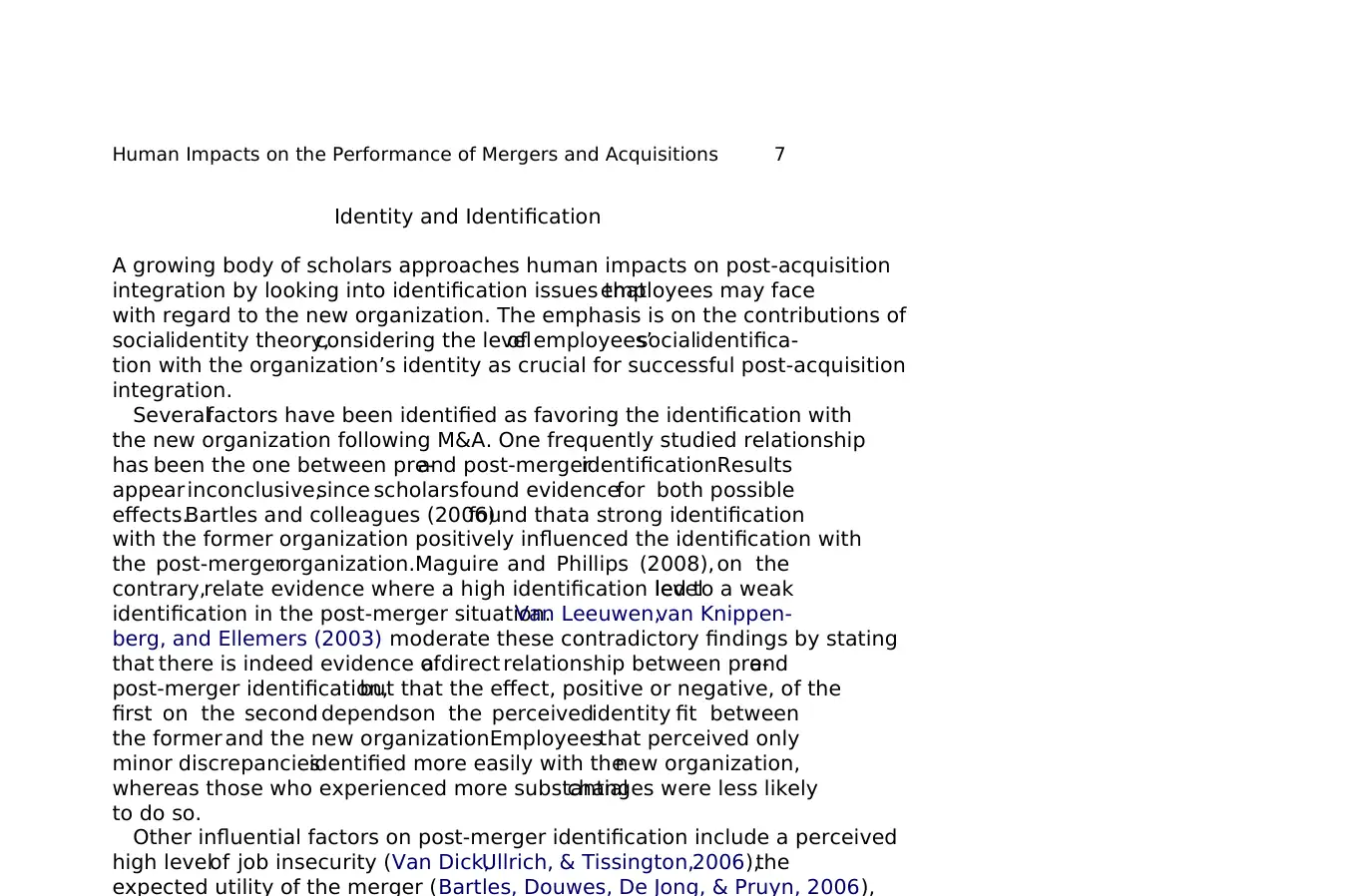
Identity and Identification
A growing body of scholars approaches human impacts on post-acquisition
integration by looking into identification issues thatemployees may face
with regard to the new organization. The emphasis is on the contributions of
socialidentity theory,considering the levelof employees’socialidentifica-
tion with the organization’s identity as crucial for successful post-acquisition
integration.
Severalfactors have been identified as favoring the identification with
the new organization following M&A. One frequently studied relationship
has been the one between pre-and post-mergeridentification.Results
appear inconclusive,since scholarsfound evidencefor both possible
effects.Bartles and colleagues (2006)found thata strong identification
with the former organization positively influenced the identification with
the post-mergerorganization.Maguire and Phillips (2008), on the
contrary,relate evidence where a high identification levelled to a weak
identification in the post-merger situation.Van Leeuwen,van Knippen-
berg, and Ellemers (2003) moderate these contradictory findings by stating
that there is indeed evidence ofa direct relationship between pre-and
post-merger identification,but that the effect, positive or negative, of the
first on the second dependson the perceivedidentity fit between
the former and the new organization.Employeesthat perceived only
minor discrepanciesidentified more easily with thenew organization,
whereas those who experienced more substantialchanges were less likely
to do so.
Other influential factors on post-merger identification include a perceived
high levelof job insecurity (Van Dick,Ullrich, & Tissington,2006),the
expected utility of the merger (Bartles, Douwes, De Jong, & Pruyn, 2006),
Human Impacts on the Performance of Mergers and Acquisitions 7
A growing body of scholars approaches human impacts on post-acquisition
integration by looking into identification issues thatemployees may face
with regard to the new organization. The emphasis is on the contributions of
socialidentity theory,considering the levelof employees’socialidentifica-
tion with the organization’s identity as crucial for successful post-acquisition
integration.
Severalfactors have been identified as favoring the identification with
the new organization following M&A. One frequently studied relationship
has been the one between pre-and post-mergeridentification.Results
appear inconclusive,since scholarsfound evidencefor both possible
effects.Bartles and colleagues (2006)found thata strong identification
with the former organization positively influenced the identification with
the post-mergerorganization.Maguire and Phillips (2008), on the
contrary,relate evidence where a high identification levelled to a weak
identification in the post-merger situation.Van Leeuwen,van Knippen-
berg, and Ellemers (2003) moderate these contradictory findings by stating
that there is indeed evidence ofa direct relationship between pre-and
post-merger identification,but that the effect, positive or negative, of the
first on the second dependson the perceivedidentity fit between
the former and the new organization.Employeesthat perceived only
minor discrepanciesidentified more easily with thenew organization,
whereas those who experienced more substantialchanges were less likely
to do so.
Other influential factors on post-merger identification include a perceived
high levelof job insecurity (Van Dick,Ullrich, & Tissington,2006),the
expected utility of the merger (Bartles, Douwes, De Jong, & Pruyn, 2006),
Human Impacts on the Performance of Mergers and Acquisitions 7
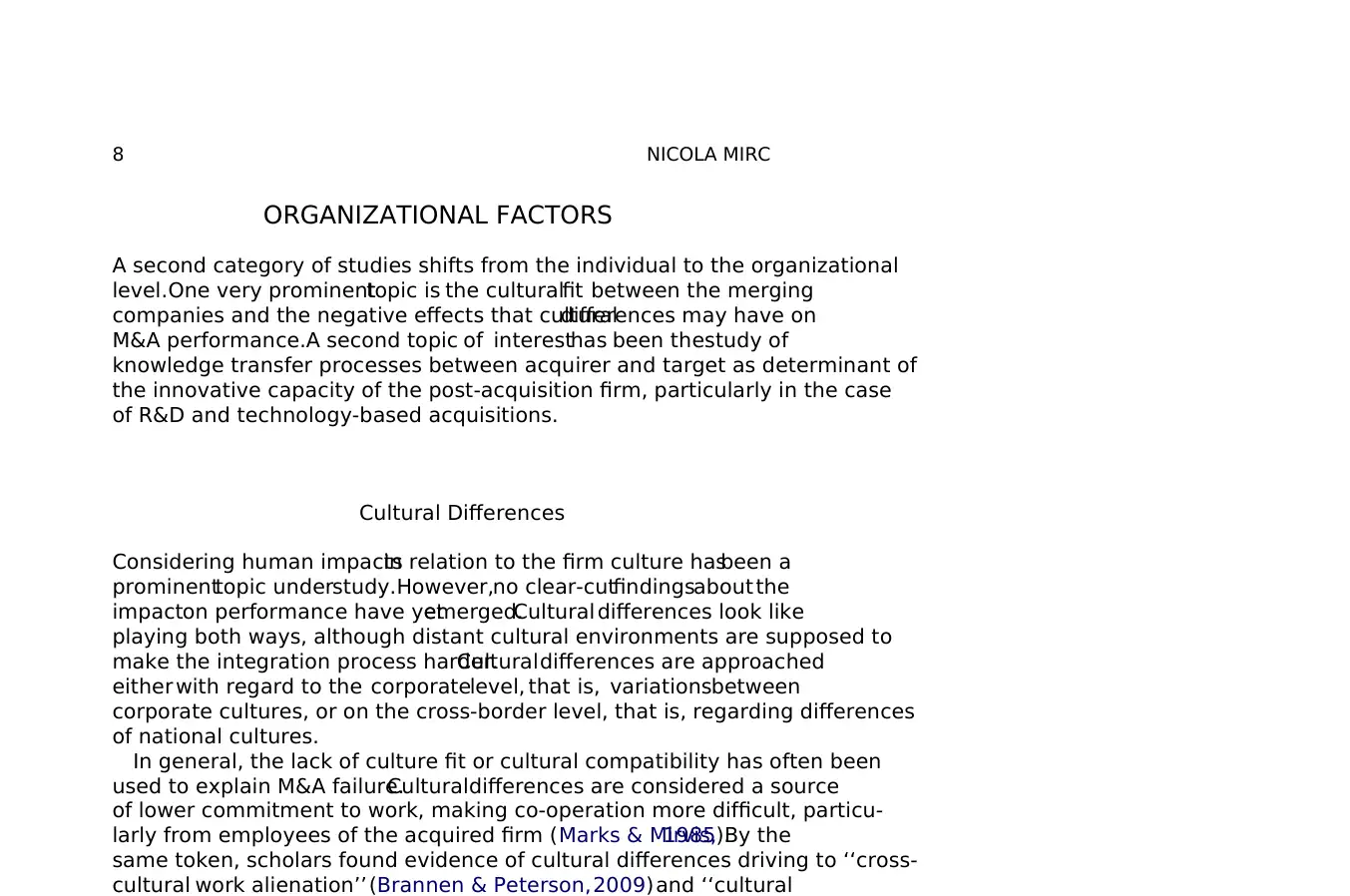
ORGANIZATIONAL FACTORS
A second category of studies shifts from the individual to the organizational
level.One very prominenttopic is the culturalfit between the merging
companies and the negative effects that culturaldifferences may have on
M&A performance.A second topic of interesthas been thestudy of
knowledge transfer processes between acquirer and target as determinant of
the innovative capacity of the post-acquisition firm, particularly in the case
of R&D and technology-based acquisitions.
Cultural Differences
Considering human impactsin relation to the firm culture hasbeen a
prominenttopic understudy.However,no clear-cutfindingsabout the
impacton performance have yetemerged.Cultural differences look like
playing both ways, although distant cultural environments are supposed to
make the integration process harder.Culturaldifferences are approached
either with regard to the corporatelevel, that is, variationsbetween
corporate cultures, or on the cross-border level, that is, regarding differences
of national cultures.
In general, the lack of culture fit or cultural compatibility has often been
used to explain M&A failure.Culturaldifferences are considered a source
of lower commitment to work, making co-operation more difficult, particu-
larly from employees of the acquired firm (Marks & Mirvis,1985).By the
same token, scholars found evidence of cultural differences driving to ‘‘cross-
cultural work alienation’’(Brannen & Peterson,2009)and ‘‘cultural
NICOLA MIRC8
A second category of studies shifts from the individual to the organizational
level.One very prominenttopic is the culturalfit between the merging
companies and the negative effects that culturaldifferences may have on
M&A performance.A second topic of interesthas been thestudy of
knowledge transfer processes between acquirer and target as determinant of
the innovative capacity of the post-acquisition firm, particularly in the case
of R&D and technology-based acquisitions.
Cultural Differences
Considering human impactsin relation to the firm culture hasbeen a
prominenttopic understudy.However,no clear-cutfindingsabout the
impacton performance have yetemerged.Cultural differences look like
playing both ways, although distant cultural environments are supposed to
make the integration process harder.Culturaldifferences are approached
either with regard to the corporatelevel, that is, variationsbetween
corporate cultures, or on the cross-border level, that is, regarding differences
of national cultures.
In general, the lack of culture fit or cultural compatibility has often been
used to explain M&A failure.Culturaldifferences are considered a source
of lower commitment to work, making co-operation more difficult, particu-
larly from employees of the acquired firm (Marks & Mirvis,1985).By the
same token, scholars found evidence of cultural differences driving to ‘‘cross-
cultural work alienation’’(Brannen & Peterson,2009)and ‘‘cultural
NICOLA MIRC8
⊘ This is a preview!⊘
Do you want full access?
Subscribe today to unlock all pages.

Trusted by 1+ million students worldwide
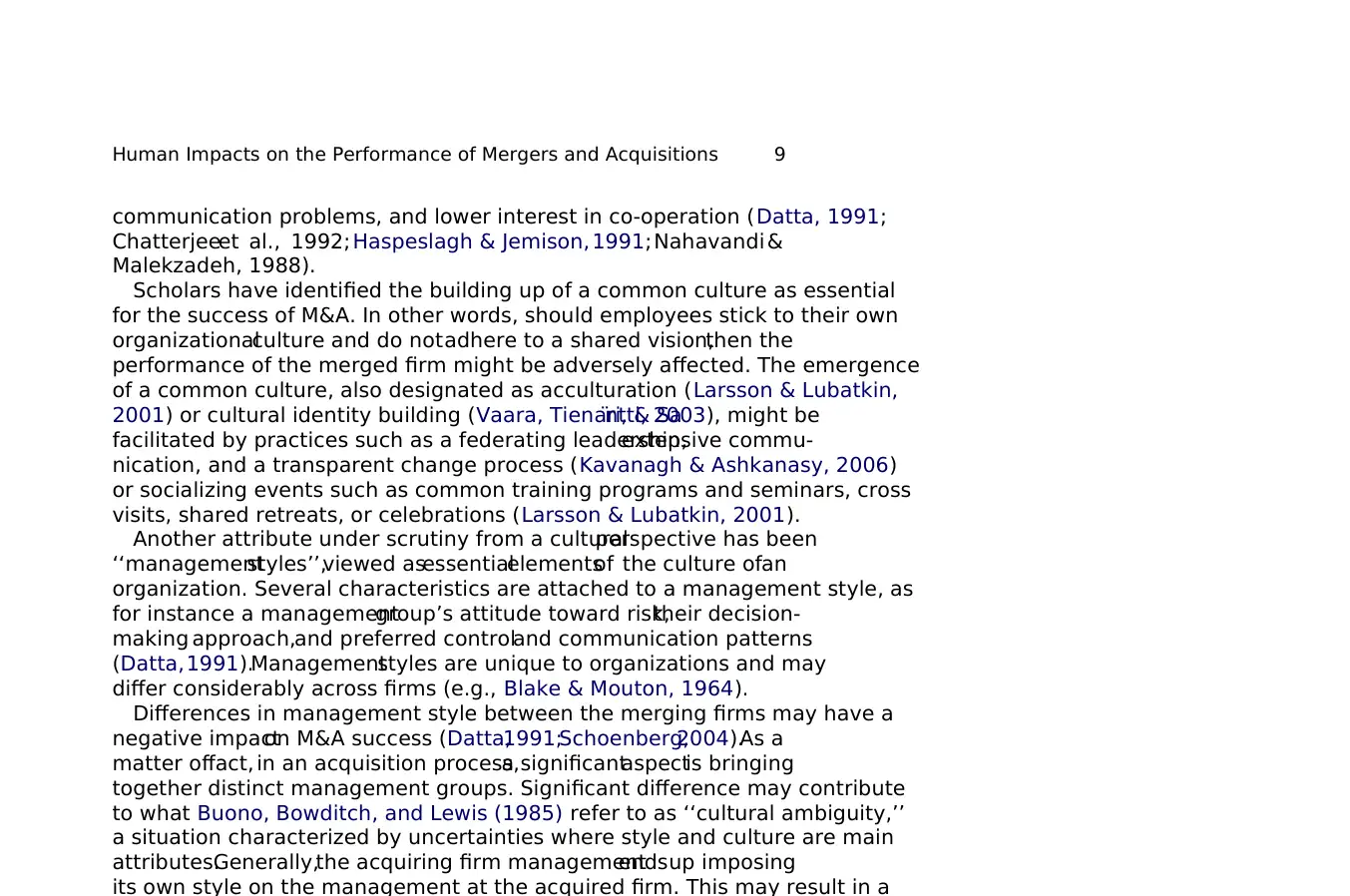
communication problems, and lower interest in co-operation (Datta, 1991;
Chatterjeeet al., 1992; Haspeslagh & Jemison, 1991;Nahavandi &
Malekzadeh, 1988).
Scholars have identified the building up of a common culture as essential
for the success of M&A. In other words, should employees stick to their own
organizationalculture and do notadhere to a shared vision,then the
performance of the merged firm might be adversely affected. The emergence
of a common culture, also designated as acculturation (Larsson & Lubatkin,
2001) or cultural identity building (Vaara, Tienari, & Sa¨ntti, 2003), might be
facilitated by practices such as a federating leadership,extensive commu-
nication, and a transparent change process (Kavanagh & Ashkanasy, 2006)
or socializing events such as common training programs and seminars, cross
visits, shared retreats, or celebrations (Larsson & Lubatkin, 2001).
Another attribute under scrutiny from a culturalperspective has been
‘‘managementstyles’’,viewed asessentialelementsof the culture ofan
organization. Several characteristics are attached to a management style, as
for instance a managementgroup’s attitude toward risk,their decision-
making approach,and preferred controland communication patterns
(Datta,1991).Managementstyles are unique to organizations and may
differ considerably across firms (e.g., Blake & Mouton, 1964).
Differences in management style between the merging firms may have a
negative impacton M&A success (Datta,1991;Schoenberg,2004).As a
matter offact, in an acquisition process,a significantaspectis bringing
together distinct management groups. Significant difference may contribute
to what Buono, Bowditch, and Lewis (1985) refer to as ‘‘cultural ambiguity,’’
a situation characterized by uncertainties where style and culture are main
attributes.Generally,the acquiring firm managementendsup imposing
its own style on the management at the acquired firm. This may result in a
Human Impacts on the Performance of Mergers and Acquisitions 9
Chatterjeeet al., 1992; Haspeslagh & Jemison, 1991;Nahavandi &
Malekzadeh, 1988).
Scholars have identified the building up of a common culture as essential
for the success of M&A. In other words, should employees stick to their own
organizationalculture and do notadhere to a shared vision,then the
performance of the merged firm might be adversely affected. The emergence
of a common culture, also designated as acculturation (Larsson & Lubatkin,
2001) or cultural identity building (Vaara, Tienari, & Sa¨ntti, 2003), might be
facilitated by practices such as a federating leadership,extensive commu-
nication, and a transparent change process (Kavanagh & Ashkanasy, 2006)
or socializing events such as common training programs and seminars, cross
visits, shared retreats, or celebrations (Larsson & Lubatkin, 2001).
Another attribute under scrutiny from a culturalperspective has been
‘‘managementstyles’’,viewed asessentialelementsof the culture ofan
organization. Several characteristics are attached to a management style, as
for instance a managementgroup’s attitude toward risk,their decision-
making approach,and preferred controland communication patterns
(Datta,1991).Managementstyles are unique to organizations and may
differ considerably across firms (e.g., Blake & Mouton, 1964).
Differences in management style between the merging firms may have a
negative impacton M&A success (Datta,1991;Schoenberg,2004).As a
matter offact, in an acquisition process,a significantaspectis bringing
together distinct management groups. Significant difference may contribute
to what Buono, Bowditch, and Lewis (1985) refer to as ‘‘cultural ambiguity,’’
a situation characterized by uncertainties where style and culture are main
attributes.Generally,the acquiring firm managementendsup imposing
its own style on the management at the acquired firm. This may result in a
Human Impacts on the Performance of Mergers and Acquisitions 9
Paraphrase This Document
Need a fresh take? Get an instant paraphrase of this document with our AI Paraphraser
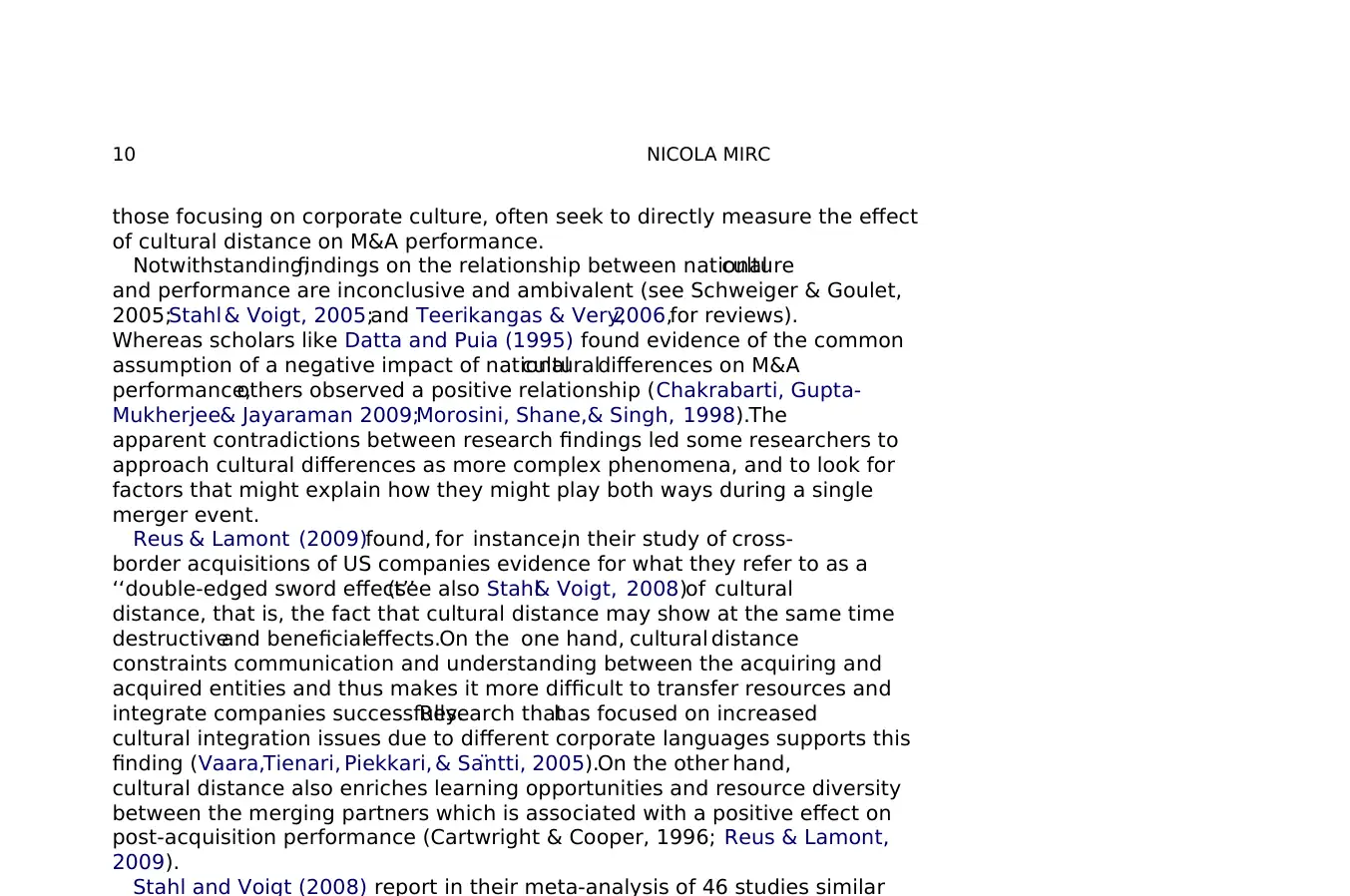
those focusing on corporate culture, often seek to directly measure the effect
of cultural distance on M&A performance.
Notwithstanding,findings on the relationship between nationalculture
and performance are inconclusive and ambivalent (see Schweiger & Goulet,
2005;Stahl & Voigt, 2005;and Teerikangas & Very,2006,for reviews).
Whereas scholars like Datta and Puia (1995) found evidence of the common
assumption of a negative impact of nationalculturaldifferences on M&A
performance,others observed a positive relationship (Chakrabarti, Gupta-
Mukherjee& Jayaraman 2009;Morosini, Shane,& Singh, 1998).The
apparent contradictions between research findings led some researchers to
approach cultural differences as more complex phenomena, and to look for
factors that might explain how they might play both ways during a single
merger event.
Reus & Lamont (2009)found, for instance,in their study of cross-
border acquisitions of US companies evidence for what they refer to as a
‘‘double-edged sword effect’’(see also Stahl& Voigt, 2008)of cultural
distance, that is, the fact that cultural distance may show at the same time
destructiveand beneficialeffects.On the one hand, cultural distance
constraints communication and understanding between the acquiring and
acquired entities and thus makes it more difficult to transfer resources and
integrate companies successfully.Research thathas focused on increased
cultural integration issues due to different corporate languages supports this
finding (Vaara,Tienari, Piekkari, & Sa¨ntti, 2005).On the other hand,
cultural distance also enriches learning opportunities and resource diversity
between the merging partners which is associated with a positive effect on
post-acquisition performance (Cartwright & Cooper, 1996; Reus & Lamont,
2009).
Stahl and Voigt (2008) report in their meta-analysis of 46 studies similar
NICOLA MIRC10
of cultural distance on M&A performance.
Notwithstanding,findings on the relationship between nationalculture
and performance are inconclusive and ambivalent (see Schweiger & Goulet,
2005;Stahl & Voigt, 2005;and Teerikangas & Very,2006,for reviews).
Whereas scholars like Datta and Puia (1995) found evidence of the common
assumption of a negative impact of nationalculturaldifferences on M&A
performance,others observed a positive relationship (Chakrabarti, Gupta-
Mukherjee& Jayaraman 2009;Morosini, Shane,& Singh, 1998).The
apparent contradictions between research findings led some researchers to
approach cultural differences as more complex phenomena, and to look for
factors that might explain how they might play both ways during a single
merger event.
Reus & Lamont (2009)found, for instance,in their study of cross-
border acquisitions of US companies evidence for what they refer to as a
‘‘double-edged sword effect’’(see also Stahl& Voigt, 2008)of cultural
distance, that is, the fact that cultural distance may show at the same time
destructiveand beneficialeffects.On the one hand, cultural distance
constraints communication and understanding between the acquiring and
acquired entities and thus makes it more difficult to transfer resources and
integrate companies successfully.Research thathas focused on increased
cultural integration issues due to different corporate languages supports this
finding (Vaara,Tienari, Piekkari, & Sa¨ntti, 2005).On the other hand,
cultural distance also enriches learning opportunities and resource diversity
between the merging partners which is associated with a positive effect on
post-acquisition performance (Cartwright & Cooper, 1996; Reus & Lamont,
2009).
Stahl and Voigt (2008) report in their meta-analysis of 46 studies similar
NICOLA MIRC10
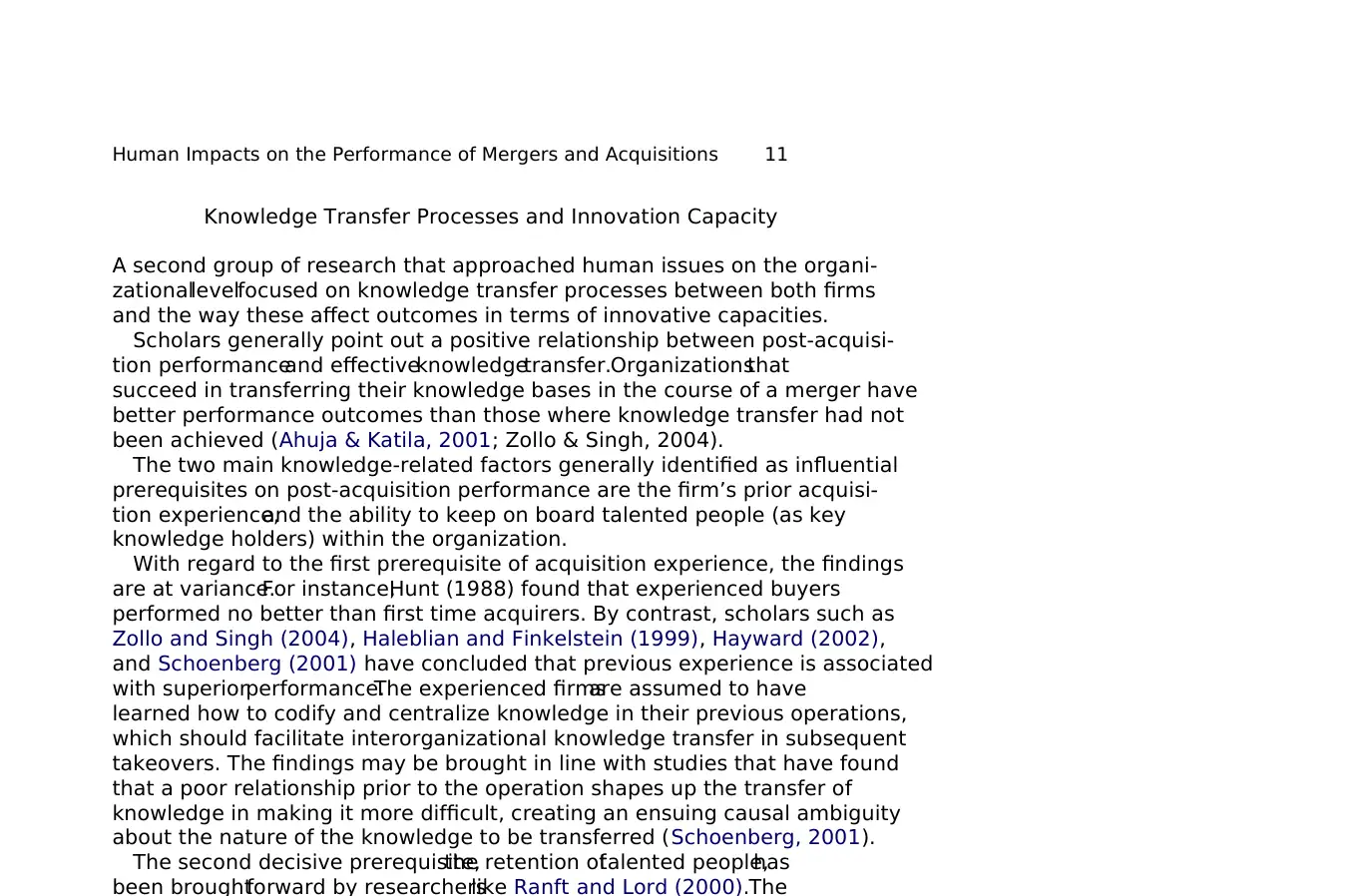
Knowledge Transfer Processes and Innovation Capacity
A second group of research that approached human issues on the organi-
zationallevelfocused on knowledge transfer processes between both firms
and the way these affect outcomes in terms of innovative capacities.
Scholars generally point out a positive relationship between post-acquisi-
tion performanceand effectiveknowledgetransfer.Organizationsthat
succeed in transferring their knowledge bases in the course of a merger have
better performance outcomes than those where knowledge transfer had not
been achieved (Ahuja & Katila, 2001; Zollo & Singh, 2004).
The two main knowledge-related factors generally identified as influential
prerequisites on post-acquisition performance are the firm’s prior acquisi-
tion experience,and the ability to keep on board talented people (as key
knowledge holders) within the organization.
With regard to the first prerequisite of acquisition experience, the findings
are at variance.For instance,Hunt (1988) found that experienced buyers
performed no better than first time acquirers. By contrast, scholars such as
Zollo and Singh (2004), Haleblian and Finkelstein (1999), Hayward (2002),
and Schoenberg (2001) have concluded that previous experience is associated
with superiorperformance.The experienced firmsare assumed to have
learned how to codify and centralize knowledge in their previous operations,
which should facilitate interorganizational knowledge transfer in subsequent
takeovers. The findings may be brought in line with studies that have found
that a poor relationship prior to the operation shapes up the transfer of
knowledge in making it more difficult, creating an ensuing causal ambiguity
about the nature of the knowledge to be transferred (Schoenberg, 2001).
The second decisive prerequisite,the retention oftalented people,has
been broughtforward by researcherslike Ranft and Lord (2000).The
Human Impacts on the Performance of Mergers and Acquisitions 11
A second group of research that approached human issues on the organi-
zationallevelfocused on knowledge transfer processes between both firms
and the way these affect outcomes in terms of innovative capacities.
Scholars generally point out a positive relationship between post-acquisi-
tion performanceand effectiveknowledgetransfer.Organizationsthat
succeed in transferring their knowledge bases in the course of a merger have
better performance outcomes than those where knowledge transfer had not
been achieved (Ahuja & Katila, 2001; Zollo & Singh, 2004).
The two main knowledge-related factors generally identified as influential
prerequisites on post-acquisition performance are the firm’s prior acquisi-
tion experience,and the ability to keep on board talented people (as key
knowledge holders) within the organization.
With regard to the first prerequisite of acquisition experience, the findings
are at variance.For instance,Hunt (1988) found that experienced buyers
performed no better than first time acquirers. By contrast, scholars such as
Zollo and Singh (2004), Haleblian and Finkelstein (1999), Hayward (2002),
and Schoenberg (2001) have concluded that previous experience is associated
with superiorperformance.The experienced firmsare assumed to have
learned how to codify and centralize knowledge in their previous operations,
which should facilitate interorganizational knowledge transfer in subsequent
takeovers. The findings may be brought in line with studies that have found
that a poor relationship prior to the operation shapes up the transfer of
knowledge in making it more difficult, creating an ensuing causal ambiguity
about the nature of the knowledge to be transferred (Schoenberg, 2001).
The second decisive prerequisite,the retention oftalented people,has
been broughtforward by researcherslike Ranft and Lord (2000).The
Human Impacts on the Performance of Mergers and Acquisitions 11
⊘ This is a preview!⊘
Do you want full access?
Subscribe today to unlock all pages.

Trusted by 1+ million students worldwide
1 out of 32
Related Documents
Your All-in-One AI-Powered Toolkit for Academic Success.
+13062052269
info@desklib.com
Available 24*7 on WhatsApp / Email
![[object Object]](/_next/static/media/star-bottom.7253800d.svg)
Unlock your academic potential
Copyright © 2020–2025 A2Z Services. All Rights Reserved. Developed and managed by ZUCOL.





